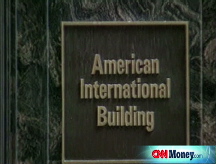Fed lends another $100B to companies
Government funding program kicks up critical short-term lending to businesses. Banks borrow less from Fed at emergency window.
NEW YORK (CNNMoney.com) -- The Federal Reserve continued its massive lending efforts to business in the past week, pumping $100 billion more into the credit stream through a new short-term funding program.
Fed numbers released Thursday showed that Fed lending in the so-called Commercial Paper Funding Facility increased to $243 billion from $144 billion a week earlier. The facility opened on Oct. 20.
The Fed's program has helped lower borrowing rates and provided critical short-term financing to businesses and financial institutions in desperate need of cash. Businesses and financial institutions have turned to the Federal Reserve for funds, as the traditional source of lending from private banks dried up after the collapse of Lehman Brothers in mid-September.
As a result, the federal government has instituted several programs aimed at easing funding concerns for banks and encouraging lending between financial institutions. These include measures such as lowering interest rates, injecting capital into banks and providing insurance on all non-interest bearing accounts.
"The Fed is tapping all the keys on the keyboard, and it does seem to be helping," said Bill Bergman, senior equity analyst at Morningstar. "We have a financial market problem of historic proportion, and I think the Fed's ability to liquefy is worth respect."
In another such program, the Federal Reserve's emergency lending window, the Fed reported that commercial banks borrowed $110 billion a day, on average, over the past week. That's down 1.7% from the $111.9 billion they borrowed from the discount window in the previous week.
For a long while before the credit crunch, the Fed has offered overnight funding for commercial banks at a rate slightly higher than its targeted funds rate. But after the collapse of Bear Stearns in March, the Fed for the first time opened its discount window to Wall Street firms like Goldman Sachs (GS, Fortune 500) and Morgan Stanley (MS, Fortune 500), which were in dire need of lending.
Investment banks borrowed $77 billion a day, on average, down 11.9% from $87.4 billion a week ago.
Some analysts have suggested that investment banks' borrowing needs have not decreased, but they are borrowing less from the discount window due to the Treasury's $250 billion capital injection into financial institutions and access to the Fed's commercial paper facility.
"We haven't seen any sign of a turnaround in lending yet," said Bergman. "The question is whether or not the Titanic is unstoppably sinking."
The Fed also reported Thursday that troubled insurer American International Group (AIG, Fortune 500) paid back $2.3 billion of its emergency loan from the Federal Reserve.
AIG now owes $81.2 billion, down from $83.5 billion as of last week. That's equal to about two-thirds of the $122.8 billion loan the federal government has offered to the company.
In mid-September, the government agreed to bail out the world's largest insurance company, which was on the verge of collapse, with an $85 billion federal loan. In addition to the bailout, the New York Fed later made available an additional $37.8 billion to the corporation through a special lending facility. The facility, which opened three weeks ago, was designed to provide funding for AIG's businesses after its securities lending division ran into trouble.
AIG announced last week that it will refinance a big chunk of its original loan. Through four of its subsidiaries, AIG said it will sell $20.9 billion of debt to the Fed and use the proceeds to pay back some of the $85 billion government bailout loan. The move allows AIG to pay down about a quarter of the loan - on which it is currently paying about 11% in interest - with money it has borrowed at 4% through the Fed's commercial paper program.
AIG has said it plans to pay off the $85 billion bridge loan by spinning off divisions.
In addition, the company's new managers, headed by government-installed CEO Edward Liddy, have agreed to withhold big payouts to former executives and curtail corporate trips in the face of criticism from Congress and other government officials. With taxpayer dollars on the line, New York Attorney General Andrew Cuomo has demanded the company halt all "unreasonable expenditures." ![]()


